Description
Advanced Joining Processes
Welding, Plastic Deformation, and Adhesion
Coordinators: da Silva Lucas F. M., El-Zein Mohamad S., Martins Paulo A.F.
Language: English
Subjects for Advanced Joining Processes:
Keywords
Additive manufacturing (EBAM); Adhesive; Adhesive joint; Adhesive joints; Aging; Aluminum; Aluminum alloys; Applications; Arc welded joints; Beam measurement; Bonding; Cold pressure welding; Copper; Destructive tests; Dissimilar welding; Durability; EB process Diagnostics; Electromobility; Electron beam welding; Explosive welding; Fastening; Fatigue; Finite element analysis; Friction stir welding; Friction welding; FSW hybridization; Fundamentals; Harder metal alloys; Hybrid; Hybrid joints; Hybrid materials; Hybrid welding; Intermetallic compounds; Joining; Laser soldering; Laser welding; Loading rate; Magnetic pulse welding; Manufacturing; Mechanical; Mechanical joining; Micro joining technology; Non-destructive tests; Numerical simulation; Plastic welding; Polymers and composites; Process simulation; Residual stress; Resistance welding; Simulation and modeling; Solid state joining; Solid-state joining; Solid-state welding; Steel; Structural adhesives; Surface treatment; Ultrasonic welding; Weld fatigue analysis; Weldability; Welding; Welding simulation
400 p. · 19x23.3 cm · Paperback
Description
/li>Contents
/li>Biography
/li>Comment
/li>
Advanced Joining Processes: Welding, Plastic Deformation, and Adhesion brings together a range of advanced thermal, mechanical, and chemical methods of joining, offering an up-to-date resource for those looking to understand and utilize the very latest techniques. Efficient joining techniques are critical to a range of innovative applications, with technology in constant development. The first section of the book provides in-depth information on advanced welding techniques, including friction stir, explosive, ultrasonic, laser, electron beam, and computational weld analysis and fatigue of structures. The second section highlights key developments in joining by plastic deformation, adhesive bonding, and hybrid joining.
The coverage of each technique is supported by practical guidance, detailed analysis, and finite element simulations. This is an essential reference for researchers and advanced students in joining, welding, adhesion, materials processing, mechanical engineering, plastics engineering, manufacturing, civil engineering, and automotive/aerospace engineering, as well as engineers, scientists, and R&D professionals, using joining, welding, and adhesion methods, across a range of industries.
Part A Welding 1. Laser welding 2. Electron beam welding 3. Computational weld analysis and fatigue of welded structures
Part B Deformation Assisted Joining 4. Deformation assisted joining 5. Friction stir welding 6. Explosive welding 7. Ultrasonic welding
Part C Adhesive Bonding 8. Manufacture and testing 9. Simulation 10. Hybrid joining techniques
Mohamad S. El-Zein has been with John Deere for 30 years and is currently the Manager of Advanced Materials and Mechanics. He is also John Deere Fellow in Materials. Dr. El-Zein obtained his PhD in Engineering Mechanics with emphasis on carbon fiber reinforced composites from Virginia Tech in 1989. He leads the Advanced Joining Group (Welding, Adhesive, and Bolted Joints), the Advanced Materials Group, and the Mechanics Group at the Moline Technology Innovation Center. Dr. El-Zein also spent much of his career in modeling and simulation and has a deep knowledge of product verification and validation. He has published research on composites, modeling and simulation, fatigue, welding, heat treating, adhesives, and computational welding simulation and analysis, and also holds over 15 patents.
Paulo Martins is Professor of Manufacturing, at the Instituto Superior Técnico, University of Lisbon, Portugal. He is also Doctor Technices Honoris Causa of the Technical University of Denmark, and a Fellow of the International Academy for Production Engineering (CIRP). He is co-author of six books, several international patents and over 350 papers in international journals and conferences. His main rese
- Presents the latest research findings and developments across welding, joining by plastic deformation, and adhesion
- Includes state-of-the-art methods, such as laser, ultrasonic and electron beam welding, hybrid joining, and the use of electromagnetic pulses
- Offers practical guidance, detailed analysis, and finite element simulations, for all techniques covered




